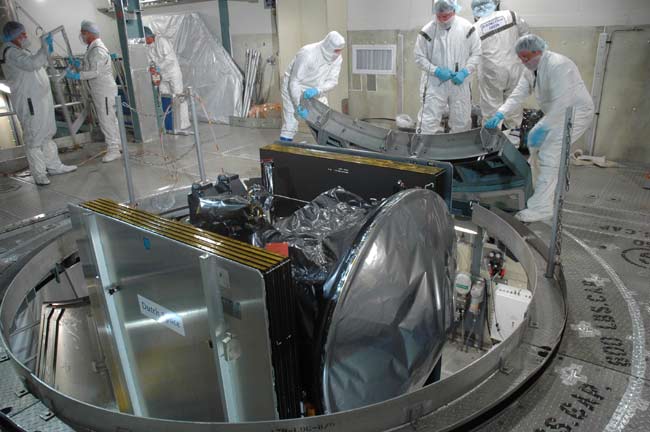NASA Watches Weather for Dawn Probe's Launch

A NASAprobe bound for the two largest space rocks in the solar system is on track fora Thursday launch, though mission managers are keeping a close eye on the weather.
Anticipatedweather conditions dipped slightly for the planned 7:20 a.m. EDT (1120 GMT) liftoffof NASA'sDawn mission to the asteroids Vesta and Ceres, with the possibility of rainshowers at launch time marking the only concern.
"Hopefully,we'll get some good weather on launch day, but we are watching some showeractivity," launch weather officer Kathy Winters said in a Tuesday missionbriefing at NASA's Kennedy Space Center in Cape Canaveral, Fla.
The chanceof rain preventing Dawn's 7:20 a.m. EDT (1120 GMT) launch from Pad 17B at Cape CanaveralAir Force Station in Florida increased 10 percent Tuesday, giving the plannedspace shot a 40 percent chance of delay, Winters said. Weather conditions areexpected to improve for Friday should Dawn's launch be delayed one moreday, she added.
Dawn'seight-year mission to the asteroid belt that girdles the Sun between theorbits of Mars and Jupiter has weathered a host of delays, and even cancellation,to become NASA's first probe aimed to fly to, and orbit, two separate celestialbodies after leaving Earth.
"Dawnwill be the first mission to journey into and explore the heart of the asteroidbelt," said Jim Adams, NASA's deputy director of the Planetary ScienceDivision at the agency's Washington, D.C., headquarters.
Propelledby a three-engine ion drive, the spacecraft is due to reach the asteroid Vestain August 2011 and spend just under a year studying the 330-mile (530-kilometer)wide space rock before heading off to a February 2015 rendezvous with thelarger Ceres. With its spherical shape and a diameter that spans 585 miles (942kilometers), Ceres is large enough to be considered a dwarf planet.
Breaking space news, the latest updates on rocket launches, skywatching events and more!
Researchershope that Dawn's $449 million mission to study the two very different asteroidswill shed new light on the intricacies of planetary formation and earlyevolution of the solar system.
NASA triedto launch Dawn earlier this summer, but bad weather and issues related to itsDelta 2 rocket and tracking assets intervened. There was, however, a silverlining to the months of launch delay for Dawn, mission managers said.
"Thebenefit is that we are going to arrive at Vesta two months early and gain twomore months of science," Adams said, adding that the probe was originallydue to reach its first asteroid in October 2011. ??
Missionmanagers added that they were confident Dawn would launch Thursday, and wereeagerly awaiting the planned liftoff a bit after daybreak.
"Ifyou live in the Bahamas, this is one time you can tell your neighbor, with astraight face, that Dawn will rise in the west," Dawn project managerKeyur Patel, of NASA's Jet Propulsion Laboratory in Pasadena, Calif., toldreporters.
- VIDEO: Dawn's Mission to Asteroids Vesta and Ceres
- GALLERY: Asteroids
- VIDEO: The Asteroid Paradox

Tariq is the award-winning Editor-in-Chief of Space.com and joined the team in 2001. He covers human spaceflight, as well as skywatching and entertainment. He became Space.com's Editor-in-Chief in 2019. Before joining Space.com, Tariq was a staff reporter for The Los Angeles Times covering education and city beats in La Habra, Fullerton and Huntington Beach. He's a recipient of the 2022 Harry Kolcum Award for excellence in space reporting and the 2025 Space Pioneer Award from the National Space Society. He is an Eagle Scout and Space Camp alum with journalism degrees from the USC and NYU. You can find Tariq at Space.com and as the co-host to the This Week In Space podcast on the TWiT network. To see his latest project, you can follow Tariq on Twitter @tariqjmalik.
